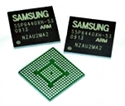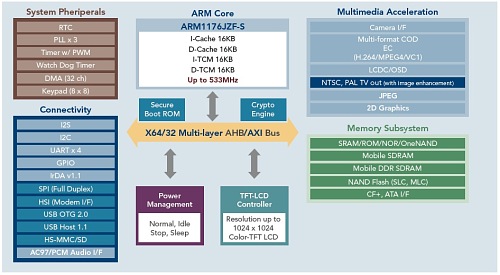Samsung shrinks ARM11 application processor
Jun 29, 2009 — by LinuxDevices Staff — from the LinuxDevices Archive — 11 views Samsung is now sampling its first ARM 11-based application processor to be fabbed using 45-nanometer technology. Intended for embedded devices such as “next-generation PNDs,” the S5P6440 processor runs at 533MHz or 667MHz, includes 2D graphics acceleration hardware, and features a DRAM memory controller, the company says.
Samsung is now sampling its first ARM 11-based application processor to be fabbed using 45-nanometer technology. Intended for embedded devices such as “next-generation PNDs,” the S5P6440 processor runs at 533MHz or 667MHz, includes 2D graphics acceleration hardware, and features a DRAM memory controller, the company says.
Samsung has provided only limited information on the new S5P6440, so we're unable to say whether the processor is merely a 45nm die-shrink of one of the company's previous 65nm processors, or provides some new capabilities. Whatever the case, the chip enters a product line that includes several earlier ARM1176-based processors, such as the S3C6410 and S3C6400 (see below for block diagram), both of which have found their way into a wide variety of products.
Thanks to its more compact size, the S5P6440 should provide lower power consumption than its predecessors, though Samsung made no claims in this respect. The chip, which supports both Linux and Windows CE, is housed in a 13 x 13mm FBGA (fine-pitch ball grid array) package with a ball pitch of 0.65mm, says the company.

A block diagram of Samsung's earlier S3C6400 processor
(Click to enlarge)
Samsung claims devices implemented with the S5P6440 can offer "vivid graphical user interfaces," thanks to 2D graphics acceleration hardware that is compliant with the OpenVG application programming interface (API) standard. In addition, the company says, the S5P6440 integrates a mobile industry processor interface (MIPI) display serial interface (DSI). It's said MIPI DSI not only reduces the number of pins required, but also, thanks to using a differential signal, "substantially" reduces electromagnetic interference (EMI) issues.
The S5P6440 also reduces design complexity by including both advanced NAND error correction hardware, supporting current- and next-generation MLC (multi-level cell) flash devices, as well as a DRAM memory controller, says Samsung. The memory controller supports both mobile DDR (mDDR) and lower-cost DDR2 memory chips, the company adds.
Stated Kwang-hyun Kim, SVP of sales and marketing at Samsung Electronics' System LSI division, "Today's ultra-competitive consumer electronics market demands rapid performance upgrades and effective cost reduction to continue its expansion. Our S5P6440 application processor is specifically designed with those objectives in mind to offer substantial improvements in CPU performance at low power, high quality graphics capability, and lower system BOM [bill of materials] cost. CE device manufacturers using the S5P6440 can offer exciting new products such as next-generation PNDs to the market in a timely manner."
Availability
According to Samsung, the S5P6440 application processor is sampling to "key" customers now, supporting Linux and Windows CE. It is scheduled for volume shipment in the third quarter of this year.
This article was originally published on LinuxDevices.com and has been donated to the open source community by QuinStreet Inc. Please visit LinuxToday.com for up-to-date news and articles about Linux and open source.